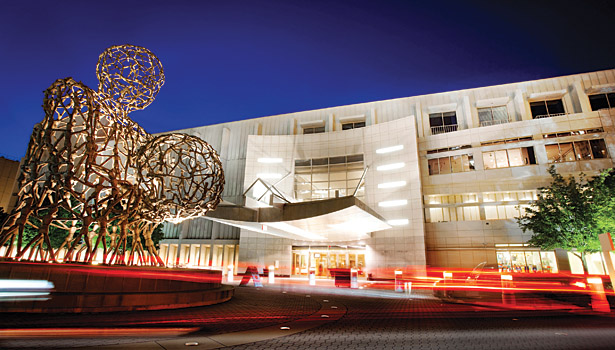Photo Caption: In an effort to eliminate disruptive airflow noises during performances, the Symphony Hall at The Woodruff Arts Center in Atlanta installed cooling towers designed with the benefit of quieter operation.
Imagine attending a symphony and right in the middle of a violin solo you hear a rushing sound penetrating the ceiling above the orchestra. Perhaps you are performing surgery in a medical center suite or giving a business presentation in the penthouse conference room of an office building and that same rushing noise generated by the facility’s HVAC cooling tower infiltrates the environment.
That rushing sound is composed of airflow noise generated by air turbulence at cooling tower fans and water flowing through the cooling tower into the collection basin. It is the bane of residents and operators of office, residential, and institutional buildings. And finding a solution can be difficult and expensive unless a more advanced cooling tower technology is applied.
In the case of the Symphony Hall at The Woodruff Arts Center, home to the Atlanta Symphony Orchestra, the noise was coming from conventional cooling towers located on the roof directly above the concert hall.
Steve Trott, director of engineering at the full-spectrum arts center campus, says the sound was similar to that of a jet aircraft passing over the Memorial Arts Building where the Atlanta Symphony performs on the top floor.
Approximately a year ago, the noise problem was eliminated and several other problems solved when new cooling towers were installed atop Memorial Arts.
“Our old, metal cooling towers were ‘end of life,’ and so we knew that we had to replace them soon,” explains Trott. “We considered typical metal towers, stainless steel, partial stainless steel . . . we looked at cross-flow and counter-flow designs. Then we looked at the HDPE-based cooling towers, which were recommended by the Atlanta office of DLB Associates Consulting Engineers. We found those cooling towers were very quiet and would provide the sound insulation needed without having to go to a special quiet tower package, which would really increase the cost.”
The HDPE (high-density polyethylene) design that Trott’s team discovered was pioneered by Delta Cooling Towers primarily to solve corrosion problems, which have plagued metal towers due to problems such as soft water and ambient factors like salt air or caustic industrial gases.
While the improved lifespan of these HDPE towers has been a major factor in purchasing decisions for years, more recently the quieter operation has taken on significant importance for many applications. The “noise pollution” of commercial HVAC equipment has become an increasingly unwanted problem for communities in recent years.
Martin M. Previtera, regional manager for Delta Cooling Towers, says that the continued development of inner cities and the closer proximity of commercial and industrial buildings to residential neighborhoods have caused heightened concerns among building owners and municipal governments.
For example, the Franklin Institute building in Philadelphia recently replaced its cooling towers, and by city ordinance was mandated to restrict the sound output to less than 50 decibels, which is less than the normal noise output of a traditional cooling tower.
“They decided on HDPE cooling towers for a combination of factors,” Previtera explains. “They were able to achieve better pricing while also meeting the dBA rating of less than 50. This is a four-cell cooling tower. They installed the same type of cooling tower at Woodruff Arts Center in Atlanta,”
To appreciate the surprising difference between decibel levels, Temple University Department of Civil/Environmental Engineering describes the difference of just 10 dBAs (A-weighted decibels, the relative loudness of sounds in air as perceived by the human ear) as very substantial, with 70 dBAs being the equivalent to a vacuum cleaner, and 50 dBA being the equivalent of a quiet suburban home.
“In many cities businesses are encroaching on residential areas, and some cities require that new office buildings incorporate residential spaces in the top portions of the buildings,” says Trott. “Certainly the occupants of those expensive spaces don’t want to hear the noise of cooling towers.”
The cooling towers that Woodruff Arts Center selected for the symphony hall building were two sets of twin-cell Delta™ Series 500-ton models, each featuring a 20-year warranty on corrosion or other physical damage.
Trott says these HDPE towers are providing other important benefits as well.
“One of the other reasons we chose these cooling towers was that they are available with direct-drive motors,” he explains. “That means no gearbox and no belt, which greatly improves operating reliability and reduces maintenance requirements. At the same time it provides significant energy savings.”
Trott adds that his new cooling towers feature VSDs for the fans, which provide smooth operation and consistent water temperature. During the first summer of operation, most of the time the fans were running at 50% speed or less, which was more economical.
Trott notes that the Delta cooling towers are unusual looking compared to traditional ones.
“Ours are a nice tan color that blends in with the roof; so that is not something that attracts the eye in a way that would notice that there is machinery on the roof. We feel that the aesthetic features of the cooling tower design are beneficial in a high-visibility location; since all of our neighbors are in taller buildings that look down on our roofs, it is nice that they are less conspicuous than traditional towers,” he said.


